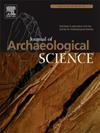Trace elements, maturation processes and diagenesis in human deciduous incisors
IF 2.5
1区 地球科学
Q1 ANTHROPOLOGY
引用次数: 0
Abstract
Post-mortem alteration of trace elements can complicate the interpretation of original biogenic signals related to diet, environment and enamel maturation processes. This study describes gradients in element concentrations for modern and archaeological deciduous incisor teeth to identify diagenetic variations in specific elements.
Fifteen human deciduous incisors (six modern and nine archaeological) were prepared for synchrotron radiation micro X-ray fluorescence (SR μ-XRF) analysis targeting the minerals Ca, P, and selected trace elements Zn, Fe, Mn, Cu, and Ba. Standard histological methods were employed to produce thin sections. Element concentrations, expressed in parts per million (ppm) and as a ratio of calcium (Ca), were measured from the outer enamel surface (OES), into the enamel, across the Neonatal Line (NNL) and enamel-dentin junction (EDJ), and into the dentin.
Diagenesis was most pronounced on the external surfaces of enamel and dentin, with notable variability in Fe, Mn, Cu, and Ba. In contrast, Ca, P, and Zn levels remained stable across samples, with a slight increase in Zn at the NNL. There was no enrichment of Zn at the OES in enamel not yet matured (less than 33–37 postnatal days), suggesting that initial zinc incorporation is overshadowed by further deposition during maturation.
Diagenetic alteration of the Fe, Mn, Cu, and Ba elements in deciduous incisor enamel appears to affect their concentration in regions of the archaeological teeth. The observed Ca and Zn distribution pattern reflects distinct enamel maturation stages, highlighting the need to consider both diagenetic influences and developmental processes in trace element analyses of ancient dental samples.
微量元素与人乳牙的成熟过程及成岩作用
死后微量元素的改变会使与饮食、环境和牙釉质成熟过程有关的原始生物信号的解释复杂化。本研究描述了现代和考古乳牙切齿元素浓度的梯度,以确定特定元素的成岩变化。制备了15颗人乳切牙(6颗现代切牙,9颗考古切牙)进行同步辐射微x射线荧光(SR μ-XRF)分析,分析了矿物Ca、P和选定的微量元素Zn、Fe、Mn、Cu和Ba。采用标准组织学方法制作薄切片。元素浓度以百万分之一(ppm)和钙(Ca)的比例表示,从外牙釉质表面(OES)进入牙釉质,穿过新生儿线(NNL)和牙釉质-牙本质连接处(EDJ)进入牙本质。成岩作用在牙釉质和牙本质的外表面最为明显,铁、锰、铜和钡的差异显著。相比之下,Ca, P和Zn的水平在样品中保持稳定,在NNL处Zn略有增加。未成熟的牙釉质(出生后少于33-37天)在OES处没有锌的富集,表明成熟过程中锌的进一步沉积掩盖了最初的锌掺入。乳牙牙釉质中Fe、Mn、Cu和Ba元素的成岩变化似乎影响了它们在考古牙齿区域的浓度。观察到的Ca和Zn分布模式反映了不同的牙釉质成熟阶段,突出了在古代牙齿样本的微量元素分析中需要考虑成岩影响和发育过程。
本文章由计算机程序翻译,如有差异,请以英文原文为准。
求助全文
约1分钟内获得全文
求助全文
来源期刊

Journal of Archaeological Science
地学-地球科学综合
CiteScore
6.10
自引率
7.10%
发文量
112
审稿时长
49 days
期刊介绍:
The Journal of Archaeological Science is aimed at archaeologists and scientists with particular interests in advancing the development and application of scientific techniques and methodologies to all areas of archaeology. This established monthly journal publishes focus articles, original research papers and major review articles, of wide archaeological significance. The journal provides an international forum for archaeologists and scientists from widely different scientific backgrounds who share a common interest in developing and applying scientific methods to inform major debates through improving the quality and reliability of scientific information derived from archaeological research.
 求助内容:
求助内容: 应助结果提醒方式:
应助结果提醒方式:


